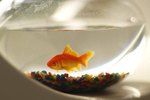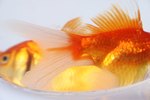
Freshwater hatchet fish require an intermediate level of care. However, if you give them the right water conditions, they can thrive in an aquarium. On top of this, they are supremely interesting fish. They are, for instance, flying fish -- they use their fins as wings to catch air jumping from the water.
Tank Setup
The proper tank makes it easier to care for hatchet fish. Foremost, make sure you have a sturdy lid. They are celebrated jumpers. The tank should be longer than it is tall to ensure they have adequate swimming space. Plant the tank densely and include floating plants in your decor, since hatchet fish like to hang out near the top of the water. Thick vegetation makes hatchet fish feel secure and less likely to hide in the recesses of the aquarium. Since hatchet fish come from dimly lit forest rivers, avoid harsh lighting in the captive habitat.
Water Conditions
Hatchet fish water chemistry requires slightly more attention than that of other fish, but not excessively so. The aquarium should already be cycled, or broken in by other fish -- never start a brand new tank with hatchet fish. They also need soft, acidic water with pH between 6.4 and 6.8. All species of freshwater hatchet fish are tropical fish, so they require water temperature of 74 to 78 degrees Fahrenheit to thrive. And as long as these conditions are met, they tend to do fine.
Feeding
Even though most hatchet fish in the pet trade are wild-caught, they adapt readily to aquarium fare. In the wild, diet consists mainly of insects and crustaceans. In captivity, hatchet fish enthusiastically eat flake food. Add variety to the diet to ensure your hatchet fish are getting all of the vitamins they need. Treat them with frozen and freeze-dried foods like brine shrimp and bloodworms occasionally to round out nutrition.
Tank Mates
Hatchet fish need to school in groups of at least six fish. In the wild, hatchet fish live in such groups for protection; they feel unsafe and stressed if you keep them in smaller groups. Stressed fish are more likely to succumb to disease. Hatchet fish will readily share a tank with other small, peaceful fish. Midwater schooling fish like tetras, and bottom dwellers like dwarf cichlids and cory catfish get along well with hatchet fish, and they help fill out other levels of the tank.
References
Photo Credits
-
Jupiterimages/Photos.com/Getty Images



